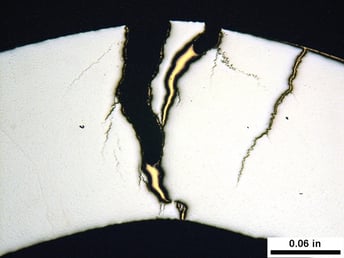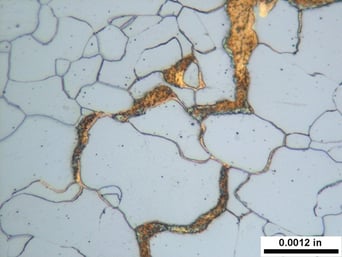Liquid Metal Embrittlement
Liquid Metal Embrittlement (LME) may occur in a brazing operation involving high-strength materials such as stainless steels, nickel alloys or age-hardened alloys, when the materials are stressed and come into contact with molten brazing filler metal. Many cases have been reported of stainless steel in a stress condition, failing due to LME.
During brazing, LME occurs when the braze filler metal is in its molten state. In an application joining cold-formed, high-stressed LME-susceptible parts (stainless steel) having a molten braze material applied to the surface of the base material. When the alloy is molten, it begins weakening the surface layer, disrupting the stress equilibrium. Areas of high stress between the grains of the base material are relieved by the liquid filler metal, which quickly causes visible cracks along the grain and/or failure in the base material.
Conditions for LME
There are three conditions necessary for LME to occur:
1. Using a material that is susceptible to LME, such as stainless steels, nickel alloys or age-hardened alloys
2. Stress in the component/part either internal or applied (e.g. fixture)
3. The presence of a liquid filler metal
Note that the part will not experience LME with just molten flux on the surface; it must have liquid filler metal on the surface.
Let's observe an occurrence of this failure mode from a metallurgical cross-section view.

Figure 1: Polished Sample Exhibiting LME, 15x.
As shown in Figure 1, the characteristic pattern of LME is a main crack that propagates into the base material, with several small cracks branching off of the main crack. Substantial crack branching is not necessary, or always observed due to the speed/time of crack propagation. Filler metal should be observed at the crack interface and intergranularly in the smaller branched crack(s).

Figure 2: 2%-Nital-Etched Sample Exhibiting LME, 820x.
As we observe in Figure 2, under high magnification, these smaller cracks exhibit that a liquid filler material has indeed penetrated in between the grains, resulting in a drastic decrease in tensile properties and brittle failure of the base metal.
The Solution
In order to correct an issue in your process that involves LME, you must remove one of the three conditions that cause LME. This could involve using an anneal or stress-relieve heat treatment to the base material, changing the base material to one that is less susceptible to LME or changing the filler metal to one that is of a higher temperature in order to stress relieve the part before the braze material becomes molten on the surface. If any one of these three conditions does not exist or is altered, LME can be avoided.
Other ways to help prevent LME include redesigning part fixtures to relieve stress and heating the joint slowly. This slow heating can be especially helpful for base metals prone to cracking during brazing, including brasses, nickel-silvers, phosphor-bronzes and silicon bronzes.
CONCLUSION:
Liquid Metal Embrittlement (LME) is a phenomenon where certain ductile metals experience a drastic decrease in tensile properties, or possibly brittle failure, when exposed to certain liquid metals. Knowing the conditions under which LME can occur-and how to avoid it-will reduce your scrap rate, improve the quality of your parts and increase the efficiency of your operation.
See Lucas-Milhaupt's complete line of braze filler metals for your operation. Also, check our October blog for more information on fixture design. Please contact us for assistance if you have questions regarding your brazing process.

